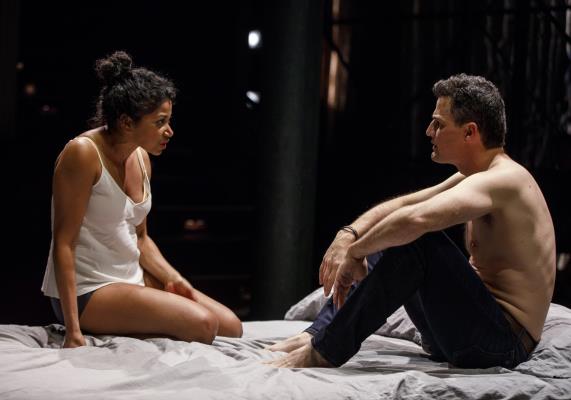

Fire in Dreamland begins with Kate (Rebecca Naomi Jones), a frustrated bureaucrat working to restore Coney Island after the devastation of Hurricane Sandy, telling her story of meeting a passionate filmmaker, Jaap Hooft (Enver Gjokaj), near the beach. A clapperboard is utilized to cut between the scene she begins to describe and herself in the ‘action’ of that scene. In this play about filmmaking and vision, the clapperboard is a clever way to establish cinematic sensibility on stage. It suggests in the theatrical space something so easily accomplished in cinematic editing—think of that famous cut in Lawrence of Arabia, where T.E. Lawrence blows out a burning match and we cut to a brilliant red sky as the sun slowly rises: instant transformation. Cinema allows us to jump effortlessly between time and space, and the clapperboard, operated by Lance (Kyle Beltran), acts as an aural cue for visual and narrative jumps in Fire in Dreamland. Unfortunately, some of the “cutting” between scenes confuses the flow of conversations and diminishes tension between and amongst the characters, becoming more of a hindrance than an enhancement of drama. Past, present, and forward get somewhat muddled, and the audience is often left feeling as if they missed something and need to catch up on their own.
Much of Fire in Dreamland relies on the audience’s own imagination of Jaap’s obsession: a film about a fire in 1911 on Coney Island that destroyed the “Dreamland” amusement park. We don’t see any of the finished product, but are subjected to Jaap’s descriptions; left to imagine the amazing footage while Kate reacts to the edited teaser, watching on her laptop. The closest we get to the fire is when Kate details her own vision of what the film could be, detailing its auspicious start and the impending chaos of animals reckoning with disaster. Kate’s enthrallment is believable, due to Jones’s enthusiasm. She finally has something to be passionate about, and wants to bring the project to fruition.
Referencing Coney Island’s famous Mermaid Parade, which Kate and Jaap attend, Jaap films footage of Kate in her mermaid costume, carrying the obligatory Nathan’s Famous cup (likely spiked with liquor). In her costume, Kate describes the dramatic fire, suggesting the gravitas and theatricality of the big top. For such an integral piece, however, the extended monologue falls flat; the addition of music, akin to what would accompany a climactic film scene, renders it comically cheesy. The play suffers from its self-awareness, hindering the necessary, sincere liberation of feeling associated with disaster stories and—barring spoilers—the most dramatic events play off uninspired and lacking pathos.
Jaap, in particular, is shockingly one note. The strict adherence to his vision, against all odds and reality, doesn’t come off as passionate but childish, annoying, and narcissistic. We don’t get any understanding of his background, his feelings, or the stakes he has in relation to Kate or Lance. The dynamic between Kate and Jaap is monotonous and bland, wanting a believable connection other than their mutual fascination with Coney Island. It could be argued that this is intentional; Kate is meant to ‘fall in love’ with Coney Island, Dreamland, and Jaap’s vision of its storied history—not Jaap himself. Sadly, Kate and Jaap cannot carry the story through its telling not showing: too much is left to the imagination.